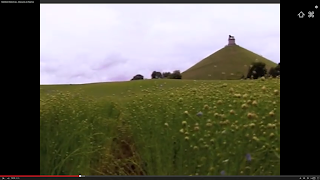There has been a recently discovered set of
watercolours, attributed to a Thomas Stoney, an Irish tourist, who visited the
battlefields at Waterloo, La Havre Sainte and Quatre Bras on 20 June 1815, only
two days after the battle. The paintings are believed to have been done on
either 20 or 21 June 1815. The set of 11 paintings has been cloistered ever
since, initially in a family collection then sold into a private collection, for
over 200 years. Having been discovered they are currently on display at the
British Museum, as part of an Exhibition entitled, ”Bonaparte and the British:
Prints and Propaganda in the Age of Napoleon”.
It is well established fact that the Duke of
Wellington was acknowledged as an astute student of military
geography. Preceding the battle he had carefully observed the terrain in the entire region surrounding Waterloo, and had mentally filed all that information away, in a turn of the phrase, “for a
rainy day”.
 |
|
Napoléon Bonaparte, First Consul
and Emperor of France (1769-1821)
|
The scene selected is believed to have been painted from the
perspective of the Chaussee de Charleroi road looking towards the northwest,
the Rue du Dimont road, Chemin des Vertes Bornes road and the memorial “Lion Mound”, subsequently constructed
by the Belgians to commemorate the battle. It would have been the exact view
seen by Napoleon’s Old Guard, as they ascended under incessant heavy fire
against the center of Wellington’s formations in the final phase of the battle.
It is said that in revisiting the battlefield, Wellington was truly enraged
that they “had destroyed his battlefield”. Principally the steep slope of the
terrain to the ridge line had been significantly lowered in order to provide
the earth necessary to construct the Lion Mound.
Readers who have previously gone through the intelligence photographic interpreter’s exercise of the landing zones(LZs) and drop zones(DZs), at the Battle of Arnhem, will probably more quickly orient to the following series of photographs. See; http://arnhemjim.blogspot.com/2015/04/an-exercise-in-photo-reconnaissance.html . If the viewer opens both of the following two paintings on their screen, and duplicates them as working copies, i.e. jpgs, then by pairing up the identical grouping of trees on the ridgeline, a panorama is generated.
Readers who have previously gone through the intelligence photographic interpreter’s exercise of the landing zones(LZs) and drop zones(DZs), at the Battle of Arnhem, will probably more quickly orient to the following series of photographs. See; http://arnhemjim.blogspot.com/2015/04/an-exercise-in-photo-reconnaissance.html . If the viewer opens both of the following two paintings on their screen, and duplicates them as working copies, i.e. jpgs, then by pairing up the identical grouping of trees on the ridgeline, a panorama is generated.
Without disturbing the panoramic view, the reader can now open the following Google Earth imagery of the battlefield as it exists today. Disregarding the Lion Mound and the adjacent buildings, it's along the Rue du Dimont and Chemin des Vertes Bornes roads that Wellington deployed his troops. See the next chart which provides the initial disposition of the troops on both sides.
Although the slope would have been much more pronounced (thus Wellington's comments about "his" battlefield being ruined), here is the almost identical view which would have been seen by the advancing formations of Napoleon's Grande Armée, in a series of modern day photographs. In addition to the arduous slope of the terrain, the incessant British artillery fire, and highly disciplined and accurate musket/rifle volley fire, the French formations faced another facet of nature. Torrential rains had fallen during the entire previous 48 hours, only to clear in the early morning hours of 18 June. The composition of the soil under foot was an oozing wet clay composition. The term referring to infantry as "foot-sloggers" took on a very real meaning. Suffices this factor also impacted Napoleon's gunners ability to service their artillery batteries (reduced rate of fire and labor to reposition pieces after each volley), as well as the effectiveness of the projectiles themselves, consequently significantly reducing the efficiency of this most feared and renowned branch of his army.
Here are three successively closer current views from Google Earth of the Rue du Dimont and Chemin des Vertes Bornes roads where the British and Allied Armies were deployed.
Finally a chart of the evolved dispositions and actions of both armies in the final stages of the battle.
For even more clarity compare the following enlarged section of the chart with the first of the three photographs shown above. The location of the Lion Mound is denoted as the green circle :
While the military geography played a significant role in the outcome of the battle, there were several other contributing factors. If the reader is so inclined, you might want to watch: http://arnhemjim.blogspot.com/2013/01/a-forensic-analysis-of-battle-of.html .
The entire group of paintings can be seen at; http://www.dailymail.co.uk/news/article-2945849/A-damn-close-run-thing-200-years-Waterloo-looked-like-just-days-battle-Wellington-beat-Napoleon.html .














No comments:
Post a Comment